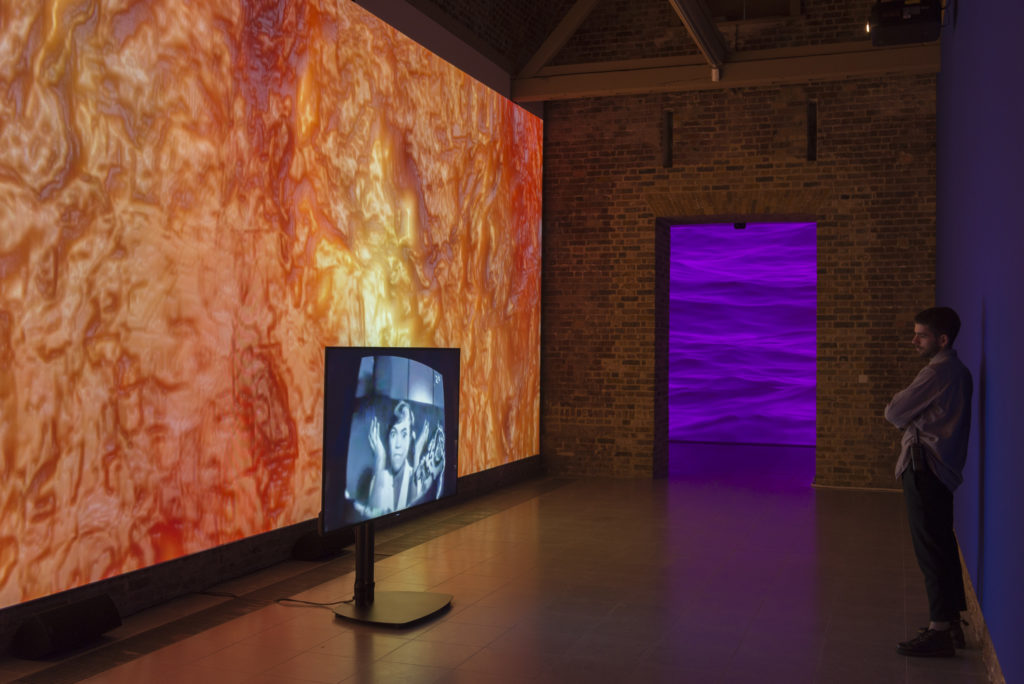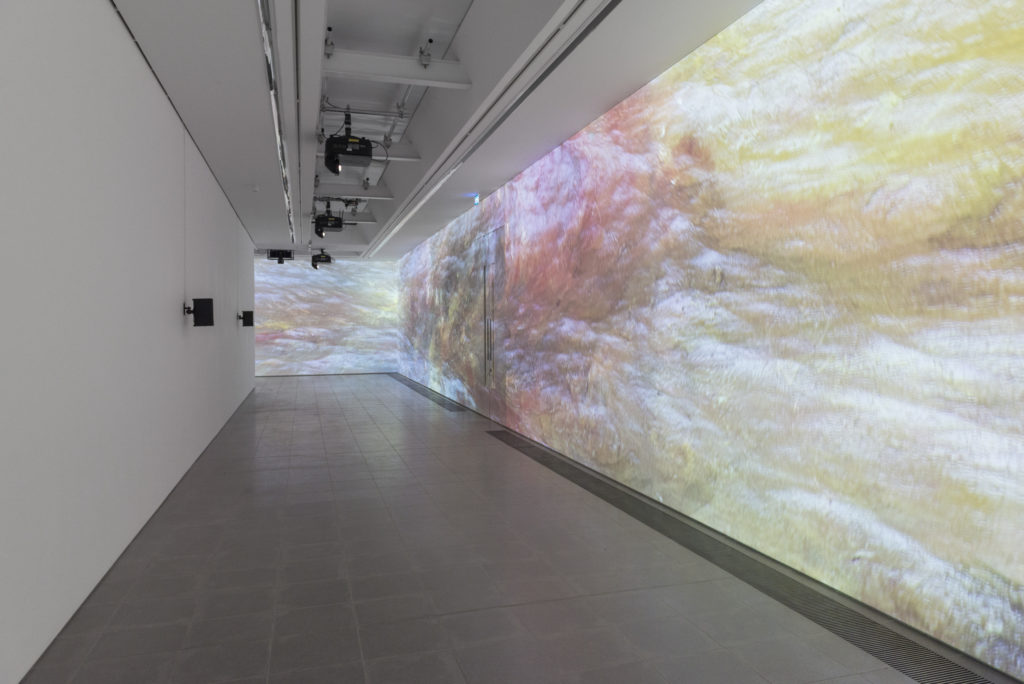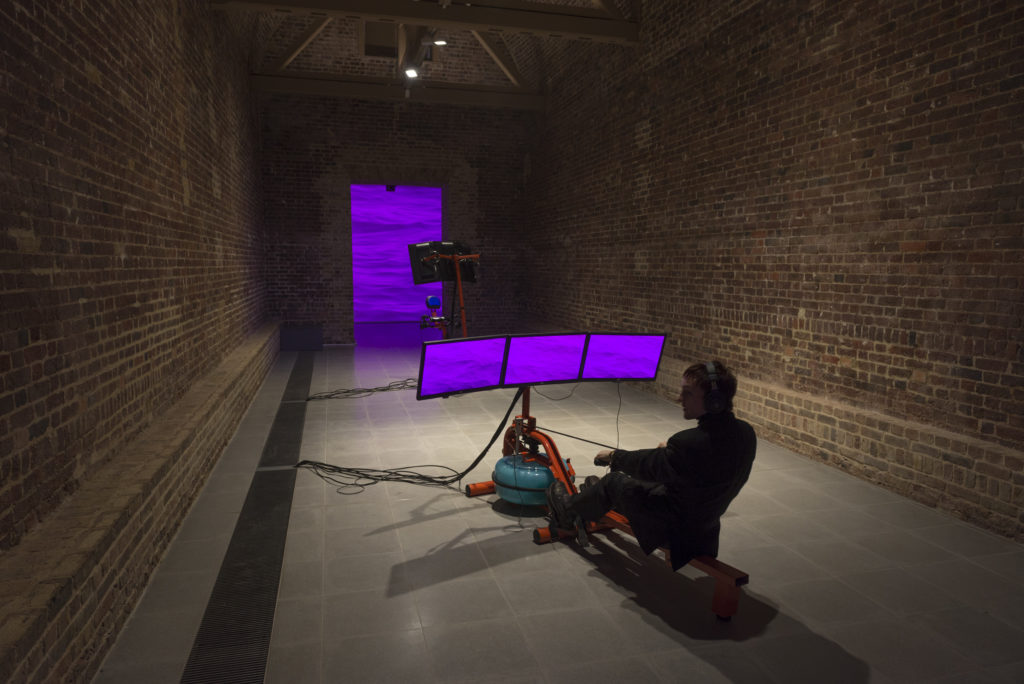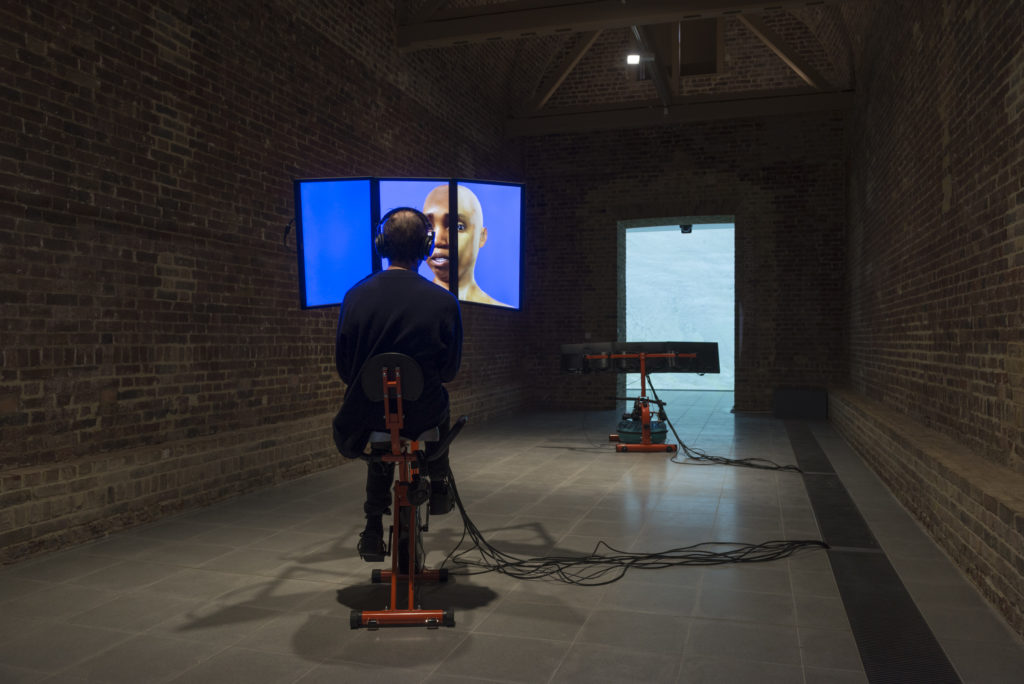“I’m using this tool to create the ocean,” says Sondra Perry, as we sit down to discuss Typhoon coming on, her first solo exhibition in Europe, running at London’s Serpentine Sackler Gallery from March 6 to May 20. Keen to express the importance of understanding the materiality of the media that she — or anyone else — creates, Perry tells me she learnt her approach to film and video through a very “hands-on, process-based” educational background. We continue talking about the Ocean Modifier tool found in the Blender Software, an open-source 3D graphics toolset. “It encompasses so many things that are true and that I’m interested in,” says the American media artist whose work critiques the technological reproduction of black subjects; “the ocean, ocean-as-modifier in the African diaspora, the thing that changed, or flipped everything over.’

The title-work and main video projection of ‘Typhoon coming on’ is a reimagined piece from 2016, based on a high resolution scan of the 1840 J.M.W. Turner painting of the Zong massacre; an event in 1781, when the captain of a British slave vessel threw around 133 enslaved people overboard in order to collect on insurance. ‘Typhoon coming on’ wraps itself around the gallery, a marbled abstraction that in seconds becomes a rippling electric purple current all around. Walking around the exhibition, the viewer is thrown into relief, washed up against it. On first entering the space, though, a chroma key blue wall is all you see. A long, uninterrupted expanse of blue, blue and nothing but blue. It’s strange to enter an exhibition and be greeted with what looks like nothing. In the midst of this field, with no other anchor in sight, your body becomes the thing. Keenly aware of yourself, adrift in the space. What’s here is you. And as you turn your head, there is another body, Amira Gad, the exhibition’s curator, and then another, Sondra Perry, dressed head-to-toe in two-tone camo.
With these immersive installations — this one featuring throbbing flesh walls, interactive workstations and the artist’s own avatar — Perry asks us to slow down, stretch out, and zoom in on the fatal errors present in contemporary accelerated media production and distribution. When we talk, the first thing we cover is the relationship between art and activism. Actually, no, pedalback. The first thing is the Naomi Campbell and Skepta GQ cover published that day. The second is art and activism, before carrying on to corporate colonialism, disillusionment with ‘visibility,’ and liberatory politics for a world in total free fall.

**Congratulations on Typhoon coming on! How has it been preparing for a UK context?
Sondra Perry: The Turner painting was first shown at the Royal Academy, which creates this emphasis here in the UK. But also, there’s a really funny YouTuber I follow called ‘Evelyn From the Internets’ who was here for a conference recently and she was like, ‘I’m here, in the Coloniser’s land…’ and that’s really how I feel. it’s almost a homecoming for this thing that’s been morphed and twisted. I am a Black American, and I understand that comes with a hypervisibility that’s hard to call ‘privilege,’ but it’s something that’s very different from the context of Black people across the world. I am always trying to make work with the diaspora in mind and to think historically — you have to in order to understand what Blackness is and what Blackness means.
**What’s with the blue walls?
SP: I’m into very basic colour ideas, like the blue screen as the post-production space that is simultaneously, in my opinion, a black space or an extraterrestrial space. In post-production CGI, they usually use ‘Chroma Key blue’ to approximate blackness as it absorbs shadows better than a Chroma Key green would. So I’m interested in the blues. Blackness and the blues. That correlation has happened a lot in music, and of course it’s happened in visual culture, but here we’re talking about ‘Chroma’ — straight-up about black and blue being the same thing. The space of post-production being the space where the thing either has yet to happen, or it has, and everything has happened. So I like surrounding the space… it’s like we have the obligation to create the images ourselves, so what are you going to do with that opportunity or responsibility and that space of the ‘post’? The space of post-production is actually the space of pre-production.

I’m really interested in how Fred Moten talks about blackness as phenomenological, as spatial. Aria Dean wrote a really awesome paper called ‘Poor Meme, Rich Meme’ where she hybrids these ideas of blackness as spatial and circulation in relation to images on the Internet. I’m also really interested in this idea of blackness as a space that moves and shifts constantly, because that’s the inherent nature, but I guess that’s also how blackness keeps it’s radicality. It has to shift. It has to move. But it also has to keep itself open to a lot of things that seem scary. We’re not talking about black people, we’re talking about this idea of black radicality that anyone can jump in and out of, and it’s necessary for anyone to be able to jump in and out of it because it has to stay fluid. The Chroma Key post-production space is that space for me.
**What, for you, are the key problematics of the reproduction and circulation of the black image — via film, TV, video, online — and how would you for instance, give agency to the black meme?
SP: Honestly, agency is a word that I don’t know much about. I don’t know if that is real or we’re just deluding ourselves into thinking that agency is a thing. but as black and brown people, I wonder what we have to gain and what we have to lose from insertion in these spaces.

Regarding the meme, and the assumption that this image of this person is this person… it’s not that person. I think there’s a problematic there that we need to think through. But the trading of blackness is highly problematic. It makes me mad. What I’m most interested in is that circulation — what it means for meaning to shift and move. Then who is doing that shifting and moving? Then in what system is that shifting taking place? I want to talk about Instagram. I want to talk about Twitter. I want to talk about how they profit off everything. They’ve made a model, Capitalism 2.0, where everything we share in those spaces can be used by us. The meaning can be shifted and all of it is profitable. That’s the thing that I’m really concerned about — the trading, the shifting of memes, of blackness, and who has access — in terms of race but also in terms of class. I personally don’t want white people trading those things — I have to be honest — but I think there are conversations that we can have together without pointing fingers about what people can use because of their background.
**In this seeming age of black visibility, how do you regard the popularized notion of visibility equals power?
SP: The whole concept of visibility assumes that you’re not in a system that wants you dead. I think a lot of people forget that many of the places we are inserted in want to kill us — and I’m not even exaggerating. We’re not supposed to be there. They put us under tremendous amounts of stress. They want us to die faster. So asking for visibility in those spaces… of course we’re going to have to do it, it’s necessary. But that is not the be-all and end-all.

So I’m fat. I’m a fat person. There are conversations around body positivity in communities that consider themselves fat — not thick, but fat as fuck, and backlash against brands that aren’t using fat models. Embedded in those criticisms is exactly the problem. Capitalism is not going to help us in this case. The reason why they use a size 12 model is because you still desire to see yourself in that way. If you think you’re going to get liberation through capitalism — the system that sells you things that you desire but can never get, it isn’t going to happen! I’ve been thinking about this specifically lately, but it’s applicable to a lot of other spaces. I’m a fat black woman. The conversations around visibility don’t include me at all.. that’s why I’m appreciative of this beautiful ass body that I live in because at least I can have an understanding. when you bring those limited ideas of visibility into how we treat ourselves politically, that’s where we get into trouble. Liberation is not happening through capitalism. There’s always going to be someone left out because that’s how it works.
**Not enough people seem critical of the ‘self-commodify for success’ model of ‘making it’ or to be thinking in more complex ways about how to place their bodies in relation to power…
SP: It took a couple of years to learn how to deconstruct images more critically and be like, ‘wait, this isn’t cool.’ So what does that mean for us? It means a refiguring of what power is, absolutely. But it also means economic opportunities for people so they don’t have to be reliant on a corporation that tells you ‘hey, I’m going to take an image of you and you should be thankful! You’re going to be grateful!’ I don’t have big answers, but I think that one way is seeing people in different ways that’s not through the lens of a multi-billion dollar corporation. Now I realise that there are so many ways to be seen and that being seen is not the be-all-end-all. I make things I can see. That’s a whole other understanding of what it is to be a being.

**How does your work deal with the problematics of technological reproduction and the breakdown that happens between the source, the source code and its circulation?
SP: One way to think through this is to always question representation inherent in the work through the tools of production. I show my hand as editor, symbolically and also literally at points. I try to do it through the actual form as much as possible. I’m always trying to give someone’s experience some room… also trying to acknowledge that I’m not making a portrait. I think a portrait always assumes a representative clarity of some sort, so I try not to do that. You think you have an understanding of what it means to be in a certain body, but you have no idea.
It’s tricky. I talk about blackness and technology, or blackness as technological a lot because our bodies, our flesh (I’ll say our flesh) is technologically connected to these things that I’m talking about. Our coming over here was related to our object associations. We were machinery. We were chattel. We were production spaces. But we were also doing a bunch of other types of production; cultural production, spiritual production…I feel that this digital ghostly space of ‘I saw someone today that looked like you, but it wasn’t you’… is also our spiritual space…of course our images are also going to live in that space of complication as well.

**Your work has this sense of un-capture-able choreography — you don’t really use HD, images go off-grid, abstraction is at play, somehow. What do you find powerful about this space?
SP: I think I’m going to have to start using some different language to talk about abstraction. I loved using the language of abstraction, but I think it’s embedded. We were talking about visibility and visibility is embedded in the space that creates the conditions in which you are visible. I think abstraction might still live in the space that creates the conditions in which you are abstracted. I’m interested in what that abstraction can be, and in a way that allows something to be experienced collectively. That’s the only reason I’m interested in installation. So, surrounding a viewer with multiple screens, surrounding the viewer with narratives that move from one physical place to another physical place. In the most basic of senses, I’m just trying to get people to move around the space. By doing that you bump into someone and you have a conversation. Everything I do, I’m trying to get closer to that space where you’re having an experience that you cannot have fully without having an understanding of where somebody else is literally standing. It’s the reason I like working with open source software, because it was created with a multitude of hands. I love that shit!
**I want to push you a little bit more on this abstraction point, perhaps tying it to the Black Radical Tradition.

Abstraction is a lot about, ‘what do I gain, what do I lose; and can I function with losing this thing? One of the texts I really love is My Black Death by Arthur Jafa. As I understand it, it’s about wanting to be destabilised a bit, and wanting to head in the space of abstraction, or about losing certain types of signifiers that are perhaps embedded in a capitalistic idea of representation or visibility that we’re still holding on to but that might not be great for us. I feel like that piece is talking about what a good death is for some of these things we don’t want to give up are. That’s what I think about abstraction. What are the good deaths to fling off some of the things related to isolation for instance, that, if not an invention of capitalism, that is totally reliant on capitalism.
**Let’s get speculative and talk about what it would be to exist outside of coding, outside of categories — is that what mundanity looks like?
SP: Oooh, that’s interesting. That’s the thing about a pleasurable death. It should be joyous to be in the jumble space, because when you’re in the jumble space, you’re no longer confined by the ridiculous fake walls of the individual. You’re not there alone. I think that’s important. You’re never there alone. You’re in freefall with everyone else. That should be good. How do we make that feel good?But I also feel like that’s a trap, because is that what all those white kids sharing memes are thinking? Like let’s all just be together? Like, this feels great! That’s a question I have because it also feels like it can be taken up by people that just want to be careless, and that’s not what I’m talking about.
[Both laugh as see a Grayson Perry ‘Liberal Elite’ badge in the Serpentine Sackler shop]
SP: Isn’t that funny!?**
If you just read all of that and need a recap, I asked Perry to describe the show in sounds as well as words…













